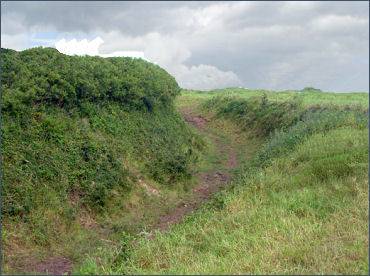Castle Dore
OS Grid ref:- SX 103 548
 The Iron Age hill fort of Castle Dore is situated near the town of Fowey was probably occupied from the fifth or fourth centuries BC until the first century BC. The fort consists of two ditches which surround a circular area measuring 79 metres (259 feet) in diameter. The fort overlooks the coastal floodplains of Par to the south west, and the path up from the River Fowey to the east.
The Iron Age hill fort of Castle Dore is situated near the town of Fowey was probably occupied from the fifth or fourth centuries BC until the first century BC. The fort consists of two ditches which surround a circular area measuring 79 metres (259 feet) in diameter. The fort overlooks the coastal floodplains of Par to the south west, and the path up from the River Fowey to the east.
The inner ditch is circular in shape and measuring 79 metres (259 feet) in diameter internally, the outer ditch arced round it from the north to the south-east before widening in the north east to form an entrance. Both ramparts appear to have been constructed from material excavated from external ditches.The ramparts were made higher at a later date and now stand 8 ft 2 in high and from the entrance which was made more complex.
Castle Dore is one of the most intensively investigated Iron Age hillforts in Cornwall. The Archaeologist Ralegh Radford conducted excavations of the fort between 1936 and 1937. At the time that Radford carried out his excavation, archaeologists concentrated on the defences when examining hillforts; Radford, however, included the interior of the fort and discovered postholes belonging to at twenty roundhouses of at least two periods.
Radford considered that a number of roughly parallel lines of post holes which he uncovered were the remains of a ‘Dark-Age timber hall’ with an attached kitchen; this he interpreted as the palace of King Mark of Cornwall, the father or uncle of Tristran of Arthurian legend.
Radford's initially thought that the fort had been reoccupied in the fifth and sixth centuries AD, however later interpretations based on a greater understanding of post-Roman archaeology concluded that the occupation at Castle Dore was restricted to the Iron Age. The use of radiocarbon dating at other sites lead to greater understanding of the contexts within which Iron Age pottery was found. The dating of the first phase of activity at Castle Dore was revised from the 2nd century BC to the 5th or 4th centuries BC.
On the 31st August, 1644, Parliamentary forces seized Castle Dore for defence against the Royalists, but were defeated.
Castle Dore lies near the village of Golant. There is some parking in a small lay-by to the south of the site from where the monument can be reached by a short walk back along the B3269 road to a gateway on the west side of the fort. Access to the site is permitted by the owner, although there is no formal right of way.